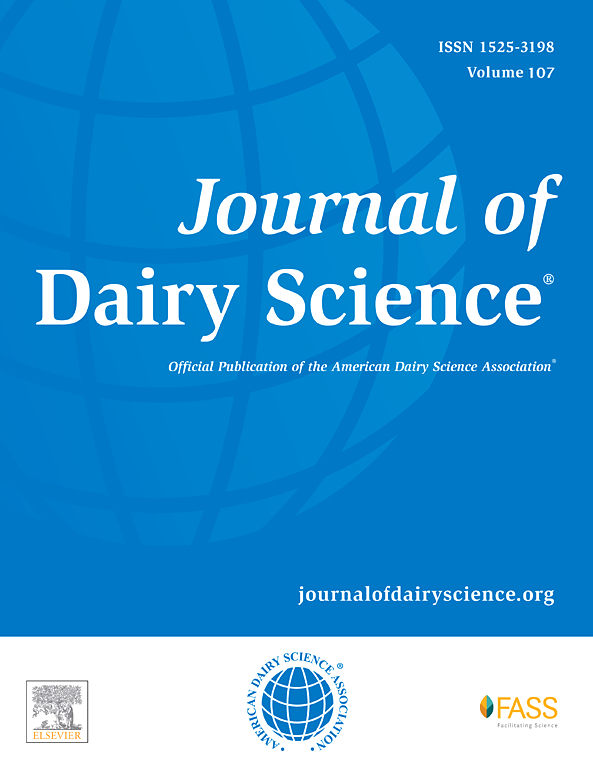Determination of A1 and A2 β-casein in cow milk by high-performance liquid chromatography tandem mass spectrometry
IF 3.7
1区 农林科学
Q1 AGRICULTURE, DAIRY & ANIMAL SCIENCE
引用次数: 0
Abstract
A2 β-CN milk has gained widespread acceptance due to its nutritional benefits. To verify the authenticity and detect adulteration and contamination in A2 milk, we developed an HPLC-MS/MS method for determining the characteristic peptides of A1 and A2 β-CN in cow milk. The method demonstrated good specificity, sensitivity, and linearity for both A1 and A2 characteristic peptides, with limit of detection of 0.01 and 0.03 mg/L, limit of quantitation of 0.03 and 0.1 mg/L, and determination coefficients of 0.9994 and 0.9992, respectively. Whereas accuracy and precision were reasonable, the recoveries varied (69.4%–151%) across concentration levels (0.04, 0.2, and 1.0 g/kg), with higher recoveries for both peptides at low concentrations and lower recoveries for A2 peptide at medium and high concentrations, influenced by factors such as adsorption and ionization efficiency. We optimized the tryptic hydrolysis conditions, selecting a trypsin-to-casein ratio of 1:25 and a hydrolysis time of 6 h at 37°C. However, the hydrolysis of A1 and A2 β-CN was incomplete and asynchronous, exhibiting parabolic relationships with their respective concentrations, with hydrolysis degrees of 12.3% for A1 β-CN and 9.6% for A2 β-CN in pure powders. We finally established a regression model to calculate the actual proportion of A1 and A2 β-CN, with the detection limits of 5% for both β-CN. In the quantitation range of this model, A1 β-CN accounting for 10% to 80% or A2 β-CN accounting for 20% to 90%, the measured value of A1/A2 or A2/A1 was a power function relationship with the theoretical value. This method effectively verifies the authenticity of A1 and A2 milk, providing a reliable tool for detecting adulteration and contamination.
HPLC-MS/MS法测定牛奶中A1和A2 β-CN的含量。
A2 β-CN牛奶因其营养价值而被广泛接受。为了验证A2牛奶的真实性和检测掺假和污染,我们建立了一种HPLC-MS/MS方法来测定牛奶中A1和A2 β-CN的特征肽。该方法对A1和A2特征肽均具有良好的特异度、灵敏度和线性,检测限分别为0.01 mg/L和0.03 mg/L,定量限分别为0.03 mg/L和0.1 mg/L,测定系数分别为0.9994和0.9992。虽然准确度和精密度合理,但不同浓度水平(0.04、0.2、1.0 g/kg)的回收率差异较大(69.4% ~ 151%),低浓度下A2肽的回收率较高,中、高浓度下A2肽的回收率较低,受吸附和电离效率等因素的影响。我们优化了胰蛋白酶水解条件,选择胰蛋白酶与酪蛋白的比例为1:25,水解时间为6 h,温度为37℃。然而,A1和A2 β-CN的水解是不完全和异步的,与它们各自的浓度呈抛物线关系,纯粉中A1 β-CN的水解度为12.3%,A2 β-CN的水解度为9.6%。最后建立回归模型计算A1和A2 β-CN的实际比例,β-CN的检出限均为5%。在本模型的定量范围内,A1 β-CN占10% ~ 80%或A2 β-CN占20% ~ 90%,A1/A2或A2/A1的实测值与理论值呈幂函数关系。该方法有效地验证了A1和A2牛奶的真伪,为掺假和污染检测提供了可靠的工具。
本文章由计算机程序翻译,如有差异,请以英文原文为准。
求助全文
约1分钟内获得全文
求助全文
来源期刊

Journal of Dairy Science
农林科学-奶制品与动物科学
CiteScore
7.90
自引率
17.10%
发文量
784
审稿时长
4.2 months
期刊介绍:
The official journal of the American Dairy Science Association®, Journal of Dairy Science® (JDS) is the leading peer-reviewed general dairy research journal in the world. JDS readers represent education, industry, and government agencies in more than 70 countries with interests in biochemistry, breeding, economics, engineering, environment, food science, genetics, microbiology, nutrition, pathology, physiology, processing, public health, quality assurance, and sanitation.
 求助内容:
求助内容: 应助结果提醒方式:
应助结果提醒方式:


